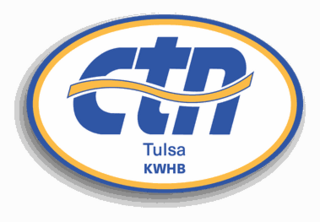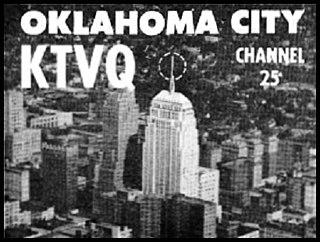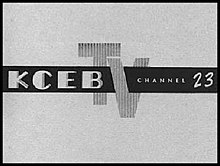
The DuMont Television Network was one of America's pioneer commercial television networks, rivaling NBC and CBS for the distinction of being first overall in the United States. It was owned by Allen B. DuMont Laboratories, a television equipment and television set manufacturer & broadcasting company. DuMont was founded in 1940 and began operation on August 15, 1946.
KDKA-TV, branded CBS Pittsburgh, is a television station in Pittsburgh, Pennsylvania, United States. It is owned and operated by the CBS television network through its CBS News and Stations division alongside WPKD-TV, an independent station. The two stations share studios at the Gateway Center in Downtown Pittsburgh; KDKA-TV's transmitter is located in the city's Perry North neighborhood. KDKA-TV, along with sister station KYW-TV in Philadelphia, are the only CBS-affiliated television stations east of the Mississippi River with "K" call signs.
KWTV-DT is a television station in Oklahoma City, Oklahoma, United States, affiliated with CBS. It is the flagship broadcast property of locally based Griffin Media, and is co-owned with MyNetworkTV affiliate KSBI. The two stations share studios on West Main Street in downtown Oklahoma City; KWTV-DT's transmitter is located on the city's northeast side.
KPXE-TV is a television station in Kansas City, Missouri, United States, affiliated with Ion Television. Owned by Inyo Broadcast Holdings, the station maintains offices on Oak Street and Cleaver Boulevard in Kansas City, Missouri, and its transmitter is located in the city's Brown Estates section.

KJRH-TV is a television station in Tulsa, Oklahoma, United States, affiliated with NBC. It is owned by the E. W. Scripps Company alongside Okmulgee-licensed Ion Television outlet KTPX-TV. KJRH-TV's studios are located on South Peoria Avenue and East 37th Street in midtown Tulsa, and its transmitter is located near South 273rd East Avenue near Broken Arrow.

KOKI-TV is a television station in Tulsa, Oklahoma, United States, affiliated with the Fox network. It is owned by Imagicomm Communications alongside MyNetworkTV affiliate KMYT-TV. The two stations share studios on East 27th Street and South Memorial Drive in the Audubon neighborhood of southeast Tulsa; KOKI-TV's transmitter is located on South 273rd East Avenue in the western city limits of Coweta.

KOTV-DT is a television station in Tulsa, Oklahoma, United States, affiliated with CBS. It is owned by Griffin Media alongside Muskogee-licensed CW affiliate KQCW-DT and radio stations KOTV, KRQV, KVOO-FM (98.5), KXBL and KHTT. All of the outlets share studios at the Griffin Media Center on North Boston Avenue and East Cameron Street in the downtown neighborhood's Tulsa Arts District; KOTV's transmitter is located on South 273rd East Avenue in Broken Arrow, Oklahoma.

KTUL is a television station in Tulsa, Oklahoma, United States, affiliated with ABC and owned by Sinclair Broadcast Group. The station's studios are located at Lookout Mountain in southwestern Tulsa, and its primary transmitter is located on South 321st Avenue East, adjacent to the Muskogee Turnpike, in unincorporated southeastern Tulsa County.

KMYT-TV is a television station in Tulsa, Oklahoma, United States, affiliated with MyNetworkTV. It is owned by Imagicomm Communications alongside Fox affiliate KOKI-TV. The two stations share studios on East 27th Street and South Memorial Drive in the Audubon neighborhood of southeast Tulsa; KMYT-TV's transmitter is located on South 273rd East Avenue in the western city limits of Coweta.

KQCW-DT is a television station licensed to Muskogee, Oklahoma, United States, serving the Tulsa area as an affiliate of The CW. It is owned by Griffin Media alongside CBS affiliate KOTV-DT and radio stations KOTV, KRQV, KVOO-FM (98.5), KXBL and KHTT. All of the outlets share studios at the Griffin Media Center on North Boston Avenue and East Cameron Street in the downtown neighborhood's Tulsa Arts District; KQCW's transmitter is located near Harreld Road and North 320 Road in rural northeastern Okmulgee County. It is also broadcast as a subchannel of KOTV-DT (6.2) from its transmitter on South 273rd East Avenue in Broken Arrow, Oklahoma.

KWHB is a religious television station in Tulsa, Oklahoma, United States, owned and operated by the Christian Television Network (CTN). The station's studios are located on Yellowood Avenue in Broken Arrow, and it transmits from atop the CityPlex Towers.
KOTV is a commercial AM radio station in Tulsa, Oklahoma. It is owned by Griffin Communications and airs an all-news radio format. Studios and offices are located across from Guthrie Green in Downtown Tulsa. The transmitter is on East 11th Street in an undeveloped area of East Tulsa.

Griffin Media is an American media company based in Oklahoma City, Oklahoma. The company began as a subsidiary of Muskogee-based Griffin Foods, which produces a line of pancake and waffle syrups and other foods.
KVOO-FM is a commercial radio station in Tulsa, Oklahoma. The station is owned by Griffin Communications and it airs a country music radio format. In 1988, the FM station picked up the heritage call sign and country format from its AM sister station. The studios are on North Boston Avenue in downtown Tulsa.

KTVX is a television station in Salt Lake City, Utah, United States, affiliated with ABC. It is owned by Nexstar Media Group alongside Ogden-licensed KUCW, an owned-and-operated station of The CW. The two stations share studios on West 1700 South in Salt Lake City; KTVX's transmitter is located atop Farnsworth Peak in the Oquirrh Mountains.
KTBZ is a commercial AM radio station in Tulsa, Oklahoma. It airs a sports radio format as an affiliate of Fox Sports Radio and is owned by iHeartMedia, Inc., with the license held by iHM Licenses, LLC. KTBZ's studios are at the Tulsa Event Center, on Yale Avenue in Southeast Tulsa.

KTVQ was a television station in Oklahoma City, Oklahoma, United States, which operated from November 1, 1953, to December 15, 1955. The station was owned by the Republic Television and Radio Company. KTVQ's studios were located on Northwest 19th Street and North Classen Boulevard in northwest Oklahoma City's Mesta Park neighborhood, and its transmitter was located atop the First National Bank Building on North Robinson and Park avenues in downtown Oklahoma City.
KMPT, UHF analog channel 19, was a dual ABC/DuMont-affiliated television station licensed to Oklahoma City, Oklahoma, United States, which operated from November 22, 1953 to February 4, 1955. Owned by KLPR Television, Inc., it was a sister outlet to radio station KLPR. KMPT's studios were located on Southwest 28th and West Commerce Streets in southwest Oklahoma City's Capitol Hill neighborhood, and its transmitter was located on East Britton Road and North Lincoln Boulevard in northeast Oklahoma City.
KGTO-TV was a television station on channel 36 in Fayetteville, Arkansas, United States. The station, which operated from 1969 to 1973, was owned by Noark Broadcasting and maintained studios at 200 West Center Street in Fayetteville.











